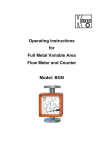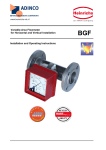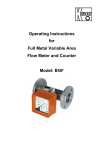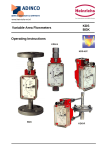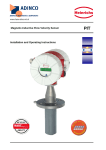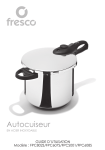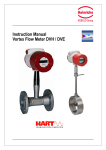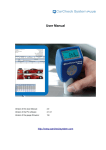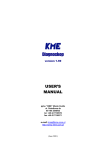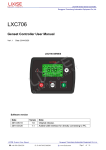Download Variable-Area Flowmeter Installation and Operating Instructions
Transcript
Variable-Area Flowmeter Installation and Operating Instructions BGN Heinrichs Messtechnik BGN Installation and Operating Instructions Contents 1 IDENTIFICATION ........................................................................................................................................... 4 1.1 Supplier/manufacturer .............................................................................................................................. 4 1.2 Product type .............................................................................................................................................. 4 1.3 Product name............................................................................................................................................. 4 1.4 Issue date................................................................................................................................................... 4 1.5 Version no.................................................................................................................................................. 4 2 APPLICATIONS ............................................................................................................................................. 4 3 OPERATIONAL MODE AND SYSTEM DESIGN........................................................................................... 4 3.1 Measuring principle................................................................................................................................... 4 3.2 System design ........................................................................................................................................... 4 4 INPUT ........................................................................................................................................................ 4 4.1 Measured variable ..................................................................................................................................... 4 4.2 Measuring range (lower-range and upper-range value)......................................................................... 4 5 OUTPUT ........................................................................................................................................................ 6 5.1 Binary output ............................................................................................................................................. 6 5.1.1 KEI 1 or KEI 2 limit transducers ............................................................................................................ 6 5.1.2 KEM 1 or KEM 2 limit transducers (special version) ............................................................................. 6 5.2 Analog output with the ES magneto-electric transmitter....................................................................... 6 5.3 Analog output with the KINAX 3W2 angle-of-rotation transmitter ........................................................ 6 6 CHARACTERISTIC VALUES ........................................................................................................................ 6 6.1 Measuring accuracy .................................................................................................................................. 6 6.1.1 Reference conditions ............................................................................................................................ 6 6.1.2 Measured error...................................................................................................................................... 6 6.1.3 Repeatability ......................................................................................................................................... 6 6.2 Influence of ambient temperature ............................................................................................................ 6 6.3 Influence of fluid temperature .................................................................................................................. 6 7 CONDITIONS OF USE................................................................................................................................... 6 7.1 Mounting requirements............................................................................................................................. 6 7.1.1 Mounting/start-up .................................................................................................................................. 7 7.1.2 Device settings...................................................................................................................................... 7 7.1.3 Adjusting the limit transducer ................................................................................................................ 7 7.1.4 Operation in hazardous areas ............................................................................................................... 8 7.2 Ambient conditions ................................................................................................................................... 8 7.2.1 Ambient temperature ranges................................................................................................................. 8 7.2.2 Storage temperature ............................................................................................................................. 8 7.2.3 Climatic category................................................................................................................................... 8 7.2.4 Degree of protection.............................................................................................................................. 8 7.2.5 Shock resistance/vibration resistance ................................................................................................... 8 7.2.6 Electromagnetic compatibility................................................................................................................ 8 7.3 Fluid conditions......................................................................................................................................... 9 7.3.1 Fluid temperature ranges ...................................................................................................................... 9 7.3.2 Diagrams: Max. ambient temperature based on the fluid temperature for the ES................................. 9 7.3.3 Fluid pressure limit .............................................................................................................................. 10 7.3.4 Inlet and outlet sections ...................................................................................................................... 10 7.3.5 Physical state ...................................................................................................................................... 10 7.3.6 Density ................................................................................................................................................ 10 7.3.7 Viscosity .............................................................................................................................................. 10 7.3.8 Pressure (for gas measurement)......................................................................................................... 10 7.3.9 Pressure loss ...................................................................................................................................... 10 Page 2 of 30 Heinrichs Messtechnik 8 BGN Installation and Operating Instructions CONSTRUCTION DETAILS ........................................................................................................................ 11 8.1 Type of construction/dimensions .......................................................................................................... 11 8.1.1 Aluminum indicator housing ................................................................................................................ 11 8.1.2 Dimension drawing for heating connection ......................................................................................... 11 8.1.3 Indicator housing made of stainless steel ........................................................................................... 12 8.2 Weight ...................................................................................................................................................... 12 8.3 Material..................................................................................................................................................... 13 8.4 Process connection ................................................................................................................................ 13 8.5 Magnetic filter .......................................................................................................................................... 13 8.6 Electrical connection .............................................................................................................................. 14 8.6.1 Wiring diagram for ES transmitter (signal output 4-20 mA with HART®) ............................................ 14 8.6.2 Wiring diagram for ES transmitter with 4-20 mA output and 2 limit transducers ................................. 14 8.6.3 Wiring diagram for ES transmitter with 4- 20 mA output, pulse output and limit transducer ................ 15 8.6.4 Wiring diagram for inductive limit transducers..................................................................................... 15 8.6.5 Wiring diagram for KINAX 3W2 transmitter with 4-20 mA output, 2 wires........................................... 16 8.6.6 Wiring diagram for KINAX 3W2 transmitter with 4-20 mA output, 3 wires........................................... 16 8.6.7 Wiring diagram for KINAX 3W2 transmitter with 4-20 mA output, 4 wires........................................... 17 8.6.8 Wiring diagram for KEM 1 and KEM 2 double-throw microswitches ................................................... 17 9 INDICATOR UNIT ........................................................................................................................................ 18 10 AUXILIARY POWER.................................................................................................................................... 18 11 CE MARK..................................................................................................................................................... 18 12 ORDER INFORMATION .............................................................................................................................. 18 12.1 Available accessories ............................................................................................................................. 18 13 STANDARDS AND DIRECTIVES, CERTIFICATES AND APPROVALS .................................................... 18 14 SAFETY INSTRUCTIONS............................................................................................................................ 18 14.1 Intended use ............................................................................................................................................ 18 14.2 Installation, start-up and operating personnel...................................................................................... 18 15 PACKAGING, MOUNTING AND SHIPMENT .............................................................................................. 18 16 MAINTENANCE ........................................................................................................................................... 18 17 INSTALLING AND REMOVING CONE, FLOAT, DAMPING SETS/SPRING STOP ................................... 19 18 TROUBLE SHOOTING ................................................................................................................................ 19 19 RETURNING DEVICES FOR REPAIR AND SERVICE ............................................................................... 19 20 REPLACEMENT PARTS ............................................................................................................................. 19 21 EXPLODED VIEWS ..................................................................................................................................... 20 21.1 Fitting with measuring element.............................................................................................................. 20 21.1.1 BGN-.... Standard version .................................................................................................................. 20 21.1.2 BGN-.... with spring stop .................................................................................................................... 20 21.1.3 BGN-.... with damping piston............................................................................................................... 20 21.1.4 BGN-.... with damping piston and spring stop ..................................................................................... 21 21.1.5 BGN-.... small measuring ranges ........................................................................................................ 21 21.2 Indicator unit............................................................................................................................................ 22 21.2.1 Complete indicator unit, local with scale ............................................................................................. 22 21.2.2 Complete indicator unit with 1 SJ 3,5 N limit transducer ..................................................................... 22 21.2.3 Complete indicator unit with 2 SJ 3,5 N limit transducers ................................................................... 22 21.2.4 Complete indicator unit with E2 KINAX Ex transmitter ........................................................................ 23 21.2.5 Complete indicator unit with E2 KINAX Ex transmitter and 1 SJ 3,5 N limit transducer ...................... 23 21.2.6 Indicator unit with transmitter type ES Ex HART® .............................................................................. 23 22 DECONTAMINATION CERTIFICATE FOR DEVICE CLEANING ............................................................... 24 23 EC TYPE EXAMINATION CERTIFICATE.................................................................................................... 25 24 SALES REPRESENTATIVES...................................................................................................................... 30 25 NOTES ...................................................................................................................................................... 30 Page 3 of 30 Heinrichs Messtechnik BGN Installation and Operating Instructions Introduction These Installation and Operating Instructions serve as a tool for the correct installation, operation and maintenance of the device. They are a supplement to the BGN Device Description. Read the manual carefully before the device is installed and put into use. It does not include special versions or applications. All devices are thoroughly checked for order compliance and operability before delivery. Upon receipt, please conduct a visual inspection of possible damage that may be identified as having occurred during shipment. If you discover any defect, please contact our head office in Cologne or the local sales office responsible for your area (see the telephone directory at the end of this manual or on our Web site). Apart from a description of the error, we will need the equipment type and serial number of the delivery. 3 3.1 Operational mode and system design Measuring principle The measuring element consists of a sharp-edged measuring ring (1) and a conical float (2). A medium flows from the bottom to the top through the measuring ring, lifting the float until the buoyancy force (A) and the weight of the float (Gs) establish equilibrium. As the height of the float varies, an annular clearance (S) proportional to the flow appears between the float and the measuring ring. The height of the float in the measuring ring is a measure of the flow. The permanent magnet (3) embedded in the float then transmits this measure to the scale and the optional electronic evaluators through a magnet tracking indicator system (4). Heinrichs Messtechnik shall not furnish guarantee for any repair work done without prior notice. Unless otherwise agreed on, the rejected parts must be made available to us in case a claim is made. 1 1.1 Identification Supplier/manufacturer Heinrichs Messtechnik GmbH Robert-Perthel-Str. 9 ⋅ D-50739 Köln Phone +49 (221) 49708 - 0 Fax +49 (221) 49708 - 92 Internet: http://www.heinrichs-mt.com/ E-mail: mailto:[email protected] 1.2 Product type Flowmeter in all-metal design based on the float principle 1.3 Product name BGN with subgroups BGN-S (stainless steel) BGN-P (PTFE) BGN-H (Hastelloy) 1.4 3.2 Issue date 08/25/2005 1.5 Version no. 6.0 File: BGN_BA_06_eng 2 System design The meter consists of a cylindrical fitting pipe with flange connections on both sides. For the measuring range from 5 to 50 l/h, a measuring ring is inserted in the tube in which a conical float can move with vertical freedom. For small measuring ranges of up to 4–40 l/h, the measuring cell consists of a conical measuring tube with cylindrical float. Applications The BGN meter is suitable for flow measurement of liquid or gaseous products in pipes. It shows the current flow rate in volume or mass per unit in time. The height of the float resulting from the flow rate is transmitted in a rotary motion by a built-in permanent magnet through a magnet tracking indicator system in a rotation to the pointer axis of the analog indicator unit. 4 Applications: flow measurement, dosing, monitoring, adjusting and control of liquid and gaseous products. The meter’s design makes it ideal for processes under difficult and adverse operating conditions. 4.1 The devices are available with additional electrical equipment for process monitoring and control. 4.2 Input Measured variable Volume flow Measuring range (lower-range and upper-range value) The lower-range value is considered 10% of the upper-range value. Measuring range span: 10-100% Smallest measuring range: 0.5-5.0 l/h water Largest measuring range: 8.000-80.000 l/h water (stainless steel) Page 4 of 30 Heinrichs Messtechnik BGN Installation and Operating Instructions : Nominal Measuring size (DN) range 15 25 40 50 80 100 1) 2) 3) 4) 5) A B C D E F G H I J K L M N P A B C D E F G H I J K L M N P Q P Q R Q R S T U T U V V W X Measuring range table Measuring range for Measuring range for air Pressure loss (mbar) water at 1000 kg/m3 at 1.013 bars absolute pressure 0.5– 5.0 I/h 0.015 – 0.15 m3/h 40 1.0 – 10 I/h 0.03 – 0.30 m3/h 44 1.6 – 16 I/h 0.045 – 0.48 m3/h 40 2.5 – 25 I/h 0.075 – 0.75 m3/h 40 4.0 – 40 I/h 0.13 – 1.3 m3/h 40 5.0 – 50 I/h 0.15 – 1.5 m3/h 40 7.0 – 70 I/h 0.2 – 2.1 m3/h 40 10 – 100 I/h 0.3 – 3.0 m3/h 60 16 – 160 I/h 0.5 – 4.6 m3/h 60 25 – 250 I/h 0.7 – 7.0 m3/h 60 40 – 400 I/h 1.0 – 11 m3/h 70 60 – 600 I/h 1.7 – 17 m3/h 80 100 – 1000 I/h 3 – 30 m3/h 60 160 - 1600 I/h 4 – 46 m3/h 70 250 – 2500 I/h 7 – 70 m3/h 100 0.5 – 5.0 I/h 0.015 – 0.15 m3/h 40 1.0 –10 I/h 0.03 – 0.30 m3/h 40 1.6 –16 I/h 0.045 – 0.48 m3/h 40 2.5 – 25 I/h 0.075 – 0.75 m3/h 40 4.0 – 40 I/h 0.13 – 1.3 m3/h 40 5.0 – 50 I/h 0.15 – 1.5 m3/h 40 7.0 – 70 I/h 0.2 – 2.1 m3/h 40 10 – 100 I/h 0.3 – 3.0 m3/h 60 16 – 160 I/h 0.5 – 4.6 m3/h 60 25 – 250 I/h 0.7 – 7.0 m3/h 60 40 – 400 I/h 1.0 – 11 m3/h 70 60 – 600 I/h 1.7 – 17 m3/h 80 100 – 1000 I/h 3 – 30 m3/h 60 160 – 1600 I/h 4 – 46 m3/h 70 250 – 2500 I/h 7 – 70 m3/h 100 400 – 4000 I/h 11 – 110 m3/h 240 250 – 2500 I/h 7 – 70 m3/h 50 400 – 4000 I/h 11 – 110 m3/h 120 600 – 6000 I/h 17 – 170 m3/h 180 400 – 4000 I/h 11 – 110 m3/h 80 600 – 6000 I/h 17 – 170 m3/h 90 1000 – 10000 I/h 29 – 290 m3/h 110 1600 –16000 I/h 46 – 460 m3/h 230 2500 – 25000 I/h 70 – 700 m3/h 500 1600 – 16000 I/h 46 – 460 m3/h 70 2500 – 25000 I/h 70 – 700 m3/h 100 4000 – 40000 I/h 110 – 1100 m3/h 350 4000 – 40000 I/h 110 – 1100 m3/h 120 6000 – 60000 I/h 170 – 1700 m3/h 360 8000 – 80000 I/h 240 - 2400 m3/h 600 for P version (PTFE), float with tantalic collar, cone of borosilicate glass measuring range: A 0.7–7.0 l/h, B 1.2–12 l/h, C 2.0–20 l/h gas throttle in S version for gas measurement included in price (pressure loss 200 mbar) not available in P version conversion not possible only in S and H version, only with smaller sealing strip Page 5 of 30 Remarks 1)+2) 1)+2) 1)+2) +2) +2) 5) 5) 5) 1)+2) 1)+2) 1)+2) +2) +2) 3)+ 4) 3) 3) 3) 3)+ 4) 3)+ 4) Heinrichs Messtechnik 5 BGN Installation and Operating Instructions Output Various electrical contact makers or transmitters may be installed in the indicator unit. 5.1 Binary output Using the segments of the slot-type initiators or the eccentric discs of the microswitches, any switching point between 10% and 90% of the flow rate can be set. 5.1.1 Safety class: PTB 97 ATEX 2271 / II 2G EEx ia IIC T6 KEI 1 or KEI 2 limit transducers 1 or 2 limit transducers, type SJ 3,5N, make Pepperl+Fuchs (special switch possible, e.g. SN version) Safety class: PTB Nr. 99 ATEX 2219 X PTB Nr. 00 ATEX 2048 X 6 Measuring accuracy 6.1.1 Reference conditions Water 20°C Double-throw microswitches whose switching point is activated by a cam plate. KEM 1 = 1 Double-throw microswitch KEM 2 = 2 Double-throw microswitches 6.1.2 Measured error (for liquids) BGN-S/H/P +/- 1.6% of URV for local display (URV = upper-range value) Maximum make-break capacity: 230 VAC 50/60Hz 6 A 24 VDC 0.5 A 110 VDC 0.2 A (for gases) BGN-S/H/P +/- 2.0% of URV for local display Additional inaccuracy for: ES = +/- 0.2% KINAX 3W2 = +/- 0.5% Analog output with the ES magneto-electric transmitter The magneto-electric transmitter is factory-calibrated to the scale values upon shipment. The signal output is supplied exclusively in a two-wire connection at 4-20 mA. Normally, the 4-20 mA signal has the HART® protocol; alternatively it can have PROFIBUS PA. Additional options: 2 limit values, alternatively 1 limit value and 1 pulse output The signal output and the limit values can be configured using a HART® modem operating on the following configuration programs: SensorPort from Bopp & Reuther, PDM from Siemens or AMS from Rosemount. Furthermore, a HART® hand-held terminal (with DD software) can also be used. For more information about configuration, please refer to the separate Operating Instructions for the ES. Safety class: DMT 00 ATEX 075 / II2G EEx ia IIC T6 When installing electrical equipment in hazardous areas, the conditions and provisions specified in the approval docmuments must be followed. 5.3 Characteristic values 6.1 5.1.2 KEM 1 or KEM 2 limit transducers (special version) 5.2 Use in hazardous areas: The angle-of-rotation transmitter is a component approved for hazardous areas. When used in hazardous areas, all the values and instructions indicated in the certificate of approval must be observed. Auxiliary power is fed through an approved intrinsically safe circuit of 12-30 V. To prove intrinsic safety, only authorized electrical equipment may be interconnected. Please take note of the maximum permissible ambient temperature of 60°C/75°C for the transmitter and the process temperature. Analog output with the KINAX 3W2 angle-of-rotation transmitter The signal output of the angle-of-rotation transmitter is factory-calibrated to the scale values. The signal output is 420 mA in 2-wire connection; or alternatively 0-20 mA in 4- or 3-wire connection. The signal output of 4 mA corresponds to the flow rate scale value of 0 (0 mA for the 0-20 mA version). 5.6 mA corresponds to 10% of the flow rate scale value (2 mA). 20 mA corresponds to 100% of the flow rate scale value. 6.1.3 Repeatability +/- 0.5 % of upper-range value 6.2 1. 2. 3. Influence of ambient temperature Without electrical equipment and with limit transducer without influence With KINAX transmitter: +/- 0.2 % / 10 K reference temperature 23°C With ES transmitter: +/- 0.5 % / 10 K reference temperature 22°C 6.3 Influence of fluid temperature Deviations in fluid temperature from the temperature observed during calibration can result in a proportional display fault because of the corresponding change in density. Changes in viscosity cause a non-linear display fault. 7 Conditions of use The VDI/VDE guidelines 3513, Sheet 3, must be observed. The meter is suitable for : 1) 2) 7.1 Liquids with sufficient flowability that are free of solids, do not bond and do not tend to settle. Gases with linear flow behavior and an adequate inlet pressure. Mounting requirements The mounting location must be suitable for a vertical direction of flow from the bottom to the top. Important: If that is impossible, then the device type BGF may be utilized. This device can be used for both horizontal and vertical direction of flow. Page 6 of 30 Heinrichs Messtechnik BGN Installation and Operating Instructions The limit values for temperature and air humidity at the mounting location must be maintained. Avoid corrosive atmospheres. If this cannot be avoided, ventilation must be installed. Please make sure that there is adequate clearance from parts that might cause magnetic interferences such as solenoid valves and ferromagnetic components like steel brackets/supports. We recommend that the minimum lateral distance between two adjacently mounted devices be 300 mm. The devices can be mounted close together if vertically offset by one device length. The minimum lateral clearance for interfering steel parts should be 200 mm. In case of doubt, check the interference by moving the device back and forth in the selected distance by about 200 mm and testing whether the pointer position changes. Select the mounting location so as to enable a reliable reading of the scale values. Please take note as well of the space requirement for any possible disassembly of the device. As a rule, inlet and outlet sections in front of and behind the device are unnecessary if the medium has a linear flow profile. Avoid mounting accessories converging on one side in front of the device. However, if this is indispensable maintain a minimum device length of 250 mm as an inlet section. The nominal size of the pipes to be connected must correspond to that of the meter. Avoid fittings converging on one side directly in front of the device. As a rule, install valves behind the measuring equipment if there are gases involved. If there is risk of dirt or solid matter penetrating the process pipes, flush them beforehand so that these materials do not get caught in the device. Ferromagnetic solid matter such as spatter can lead to the breakdown of the device. If these materials are still present during normal operating conditions, mount a magnetic filter (accessory) in front of the device. When using liquids, flush to avoid a surge of gas bubbles. Slowly increase the supply pressure when using gases to prevent pressure surges. Basically, avoid activation using solenoid valves to prevent the float from shooting upwards. 7.1.1.1 Gas measurement When using gases, slowly let the operating pressure rise. At the same time, vary the operating pressure through a setting valve so that the float is not knocked around since otherwise this would damage the measuring element. 7.1.2 1 contact device: - Minimum contact switching point at 10% of descending flow (damped/closed-circuit principle). 2 contact devices: Minimum contact switching point at 10% of descending flow and maximum contact switching point at 90% of ascending flow. 7.1.3 7.1.1 Mounting/start-up The device must be mounted in accordance with the direction of flow from the bottom to the top (perpendicularly). Please observe the prior reference to the BGF-type device. Device settings The measuring equipment is delivered ready for operation according to your order specifications. The limit transducers are set to the desired values. If you have submitted no requirements, the basic setting for Adjusting the limit transducer The contacts are adjustable through the contact position indicators located on the scale. Dismantle the indicator cover, unfasten the contact position indicators, set to the desired value and reattach them. The nominal size of the device and that of the pipes must be the same. The pressure stages and, hence, the dimensions of the flanges must coincide. The surface roughness of the flange sealing surface must be suitable for the prescribed gaskets. Please check whether possible accessories like spring stops, gas/liquid-type dampers are still correctly sitting on the flange. Check whether the mounting clearance between the flanges of the pipes corresponds to the assembly dimension of the device plus two gaskets. To achieve stress-free mounting, the flanges of the pipes must be aligned parallel to each other. Use connecting bolts and gaskets in the prescribed dimensions. The gaskets must be suitable for the operating pressure, the temperature and the measured medium. With PTFE-coated devices, use gaskets whose interior and exterior diameter correspond to the sealing strip of the device. Tighten the screws crosswise so that the process connections are tight. See to the tightening torques of screws especially with PTFE-coated devices. The maximum torques for PTFE-coated devices are: DN15/DN25 = 14 Nm/DN50 = 25 Nm/DN80 = 35 Nm/DN100 = 42 Nm (following VDI/VDE Guideline 3513). Please check whether the pipe is adequately stable to rule out the possibility of vibration or swinging of the device. (Do not use steel mounting parts on the device.) When gas is used as the medium, pay special attention to the position of the valve. If the device is calibrated to more than 1.013 bars absolute pressure, the valve is usually installed behind the flowmeter. At 1.013 bars absolute pressure (free exhaust) install it in front of the device. Page 7 of 30 Heinrichs Messtechnik 7.1.4 7.1.4.1 BGN Installation and Operating Instructions Operation in hazardous areas Example for calculating the max. fluid temperature based on the max. ambient temperature for the built-in sensor Type ES for DN 15/25. Without electrical equipment The basic version of the flowmeter is a non-electrical device without its own ignition sources and meets DIN EN 13463-1 requirements. It can be used in hazardous areas that require Category 2 equipment. ⎛ 70°C − 60°C ⎞ ⎛ Ta − Tamb ⎞ Tm = ⎜ ⎟ + 60°C = 110°C ⎟ + Tamb = ⎜ F 0,2 ⎝ ⎠ ⎝ ⎠ II 2GD c Marking: Ta = 70°C Tamb = 60°C F = 0.2 Reg. No.: BVS 03 ATEX H/B 112 Tech. File Ref. 03-02 X 7.1.4.2.1 Since the device does not have its own power sources that would result in a temperature increase, the fluid temperature is decisive for the maximum surface temperature. When used in potentially explosive dust atmospheres, the device must be cleaned regularly in order to avoid deposits exceeding 5 mm. 7.1.4.2 PTB 99 ATEX 2219 X II 2G EEx ia IIC T6-T4 7.1.4.2.2 When the limit transducers are installed, the device becomes an electrical assembly and receives a marking in accordance with DIN EN 50014 from the entire device with the built-in electrical limit transducers. The electrical and thermal data and the special conditions of the EC Type Examination Certificate of the built-in limit transducers must be observed (see also the diagram in Section 7.3.2). The influence of the fluid temperature on the built-in limit transducers must be observed. The overtemperature of the maximum fluid temperature based on the maximum ambient temperature must be considered with a factor according to the following table: Factor for standard version DN15 and DN25 DN40 and DN50 DN80 and DN100 0.2 0.25 0.3 Factor for the device with the indicator pulled forward 0.07 0.085 0.1 Example for built-in limit transducer for DN 15 and DN 25: 7.1.4.2.3 Tü = Ta = Tamb = 40°C Tm = 120°C F = 0.2 T4 7.2 7.2.1 Ambient conditions Ambient temperature ranges Without electrical accessories: -40°C to +80°C With limit transducer: -40 °C to +65°C With KINAX signal output: -40°C to +60°C With ES signal output: -40°C to +70°C For the hazardous area version, take note of the maximum ambient temperatures depending on the temperature class as specified in the Type Examination Certificate. Storage temperature The storage temperatures are identical to the ambient temperature ranges. 7.2.3 Overtemperature Ambient temperature of limit transducer Climatic category Weather-protected and/or unheated locations, class C according to IEC 654 Part 1 7.2.4 Tü = Tm − Tamb = 120°C − 40°C = 80°C Ta = Tü * F + Tamb = 80°C * 0,2 + 40°C = 56°C Degree of protection IP 65 (Aluminum indicator unit) IP 67 (Stainless steel indicator unit) In accordance with the tables in the PTB 99 ATEX 2219 X EC Type Examination Certificate, the SJ 3,5-... N... inductive sensor must be operated in the T5 temperature class with an intrinsically safe circuit that does not exceed the maximum values of the Type 3 circuit. When using the device in hazardous areas, follow the applicable national installation rules. Marking for the device when the KINAX 3W2 angle-of-rotation transmitter is built in PTB 97 ATEX 2271 II 2G EEx ia IIC T6 7.2.2 Max. ambient temperature Max. fluid temperature Factor for brought-in heat Temperature class Marking for the device when the ES magnetoelectric transmitter is built in DMT 00 ATEX 075 II2G EEx ia IIC T6 With built-in electrical limit transducers Nominal size Marking for the device when the SJ 3,5...N... limit transducer is built in 7.2.5 Shock resistance/vibration resistance The meter should be protected from extreme shocks and vibrations, which could cause damage. 7.2.6 Electromagnetic compatibility EN 61000-6-2:1999 Immunity industrial environment EN 50081-1 Emitted interference residential environment EN 55011:1998+A1:1999 Group 1, Class B NAMUR recommendation NE 21 Page 8 of 30 Heinrichs Messtechnik 7.3 BGN Installation and Operating Instructions Fluid conditions 7.3.1 Fluid temperature ranges BGN-S/H : - 40°C to +200°C Special design: -80°C to +350°C BGN-P : - 20°C to +125°C 7.3.2 Diagrams: Max. ambient temperature based on the fluid temperature for the ES Standard version Max. ambient temperature [°C] 70,0 60,0 50,0 40,0 30,0 20,0 70 80 90 100 110 120 130 140 150 160 170 180 190 200 160 170 180 190 200 Fluid temperature [°C] DN15/25 DN40/50 DN80/100 Indicator pulled forward Max. ambient temperature [°C] 70,0 65,0 60,0 55,0 70 80 90 100 110 120 130 140 150 Fluid temperature [°C] DN15/25 DN40/50 Page 9 of 30 DN80/100 Heinrichs Messtechnik 7.3.3 BGN Installation and Operating Instructions Fluid pressure limit Standard design BGN-S/H – DN 15/25/40/50/80 PN 40; DN 100 PN 16 Special design – up to PN 400 BGN-P – DN 15/25/50/80/100 PN 16 7.3.4 Inlet and outlet sections Inlet and outlet sections are not required for a linear flow profile of the fluid. For an extremely non-linear flow profile (e.g. shut-off/control valves are located in front of the meter), we recommend an inlet section with a mounting length of 250 mm (see also guidelines in accordance with VDI/VDE 3513). 7.3.5 Physical state Liquid or gaseous 7.3.6 Density Liquids: up to 2.0 kg/l Gases: no restrictions 7.3.7 Viscosity The influence of viscosity depends on various factors. Therefore, it must be calculated for each application. 7.3.8 Pressure (for gas measurement) The measured values only apply to the calibrated fluid data stated on the scale. Any change or deviation in pressure will cause a display fault. 7.3.9 Pressure loss Depends on the meter size and the measuring range (see Measuring range table). Page 10 of 30 Heinrichs Messtechnik 8 BGN Installation and Operating Instructions Construction details 8.1 8.1.1 Type of construction/dimensions Aluminum indicator housing 8.1.2 Dimension drawing for heating connection i.d. Deviating mounting dimensions: i.d. * +100 mm with the indicator pulled forward Dimensions: 8.1.2.1 DN 15 25 40 50 80 100 PN 40 40 40 40 16 16 i.d. 26 32 46 70 102 125 A 74 77 88 97 113 126 B Flange 110 110 130 140 160 175 B Ermeto 53 58,5 63 77,5 93,5 110 B S 150 150 150 150 150 120 Connections for heating jacket Pipe for Flange in acc. with DIN Flange in acc. with ANSI Ermeto 12 mm DN 15 or DN 25 ½“ The DN 25 flange is a special version. Page 11 of 30 PN 40 150 lbs Heinrichs Messtechnik 8.1.3 steel BGN Installation and Operating Instructions Indicator housing made of stainless 8.2 Nominal size DN 15 DN 25 DN 40 DN 50 DN 80 DN 100 Weight [kg] 3 4.2 6 7.5 13 18 Nominal size ¾“, 150 lbs, ANSI B16.5 1“, 150 lbs, ANSI B16.5 1 ½“, 150 lbs, ANSI B16.5 2“, 150 lbs, ANSI B16.5 3“, 150 lbs, ANSI B16.5 4“, 150 lbs, ANSI B16.5 Weight [kg] 3 Nominal size ¾“, 300 lbs, ANSI B16.5 1“, 300 lbs, ANSI B16.5 1 ½“, 300 lbs, ANSI B16.5 2“, 300 lbs, ANSI B16.5 3“, 300 lbs, ANSI B16.5 4“, 300 lbs, ANSI B16.5 Weight [kg] 3.4 i.d. i.d. = inside diameter DN 15 25 40 50 80 100 PN 40 40 40 40 16 16 Inside diameter 26 32 46 70 102 125 Weight A 100 103 110 122 138 151 Deviating mounting dimensions: * +100 mm with the indicator pulled forward Page 12 of 30 4.2 6 7.5 13 18 4.7 6.8 8.5 14.5 20 Heinrichs Messtechnik 8.3 BGN Installation and Operating Instructions Material Fitting Type BGN – S BGN – P BGN – H BGN – H Measuring tube Lining of measuring tube Stainless steel none Stainless steel PTFE Hastelloy HC4 none Hastelloy HC4 none DN15/25 ¾“/1“ > DN40 / 1½” Indicator Type BGN – S/P/H Optional 8.4 Base plate Aluminum Stainless steel Flanges Flange lining Float Stainless steel Stainless steel Hastelloy HC4 Stainless steel none PTFE none Hastelloy HC4 Stainless steel PTFE Hastelloy HC4 Hastelloy HC4 Housing Aluminum, safety glass window Stainless steel, safety glass window Process connection DN 15 DN 25 DN 40 DN 50 DN 80 DN 100 BGN-S/H PN 40 PN 40 PN 40 PN 40 PN 40 PN 16 BGN S/ H 1) ANSI ¾“ B16.5 150 lbs 1) ANSI 1“ B16.5 150 lbs 1) ANSI 1 ½“ B16.5 150 lbs 1) ANSI 2“ B16.5 150 lbs 1) ANSI 3“ B16.5 150 lbs 2) ANSI 4“ B16.5 150 lbs 1) Entire device PN 40 2) Entire device PN 16 BGN-P PN 16 PN 16 PN 16 PN 16 PN 16 PN 16 BGN P 1) 300 lbs 1) 300 lbs 1) 300 lbs 1) 300 lbs 1) 300 lbs 2) 300 lbs 2) 150 lbs 2) 150 lbs 2) 150 lbs 2) 150 lbs 2) 150 lbs 2) 150 lbs Additional equipment: special flanges, union, food connection, welding connection The S/H versions in special design are available up to PN 400. 8.5 Magnetic filter The BGN flowmeter is sensitive to impure media. Before installing the device, clean the pipes of dirt, spatter and other foreign matter. If the medium comes with solid particles, connect a suitable filter in series. When dealing with flow media with ferrous particles, we recommend the connection of a magnetic filter. To protect both magnetic filter types, MF-S (stainless steel) and MF-P/S (PTFE/stainless steel), from corrosion, encapsulated permanent magnets are laid out in spiral form. The spiral mounting produces optimum effect at small pressure loss. The filter can be supplied with groove or tongue, projection or return, other standards or special connections according to customer wishes. Dimensions: DN 15 25 40 50 65 80 100 g (mm) 45 68 88 102 122 138 158 Page 13 of 30 2) 300 lbs 2) 300 lbs 2) 300 lbs 2) 300 lbs 2) 300 lbs 2) 300 lbs Heinrichs Messtechnik 8.6 BGN Installation and Operating Instructions Electrical connection Wiring To connect the auxiliary power, remove the indicator cover, insert the connector cable into the cable gland and attach it to the terminals according to terminal diagram. Tighten the cable gland securely, remount the indicator cover and close it tightly. 8.6.1 Wiring diagram for ES transmitter (signal output 4-20 mA with HART®) 8.6.2 Wiring diagram for ES transmitter with 4-20 mA output and 2 limit transducers Page 14 of 30 Heinrichs Messtechnik BGN Installation and Operating Instructions 8.6.3 Wiring diagram for ES transmitter with 4- 20 mA output, pulse output and limit transducer 8.6.4 Wiring diagram for inductive limit transducers Page 15 of 30 Heinrichs Messtechnik BGN Installation and Operating Instructions 8.6.5 Wiring diagram for KINAX 3W2 transmitter with 4-20 mA output, 2 wires 8.6.6 Wiring diagram for KINAX 3W2 transmitter with 4-20 mA output, 3 wires Page 16 of 30 Heinrichs Messtechnik BGN Installation and Operating Instructions 8.6.7 Wiring diagram for KINAX 3W2 transmitter with 4-20 mA output, 4 wires 8.6.8 Wiring diagram for KEM 1 and KEM 2 double-throw microswitches Page 17 of 30 Heinrichs Messtechnik BGN Installation and Operating Instructions - 9 - Indicator unit Analog indicator approx. 90° with pointer Customized product scale ES transmitter with freely programmable user interface Parameters may be changed based on the ES Operating Instructions. - EN 61010 – Safety requirements for electrical measuring, control and laboratory devices EN 60947-5-6:2000 – Switchgear and controlgear Directive 97/23/EC (Pressure Equipment Directive) 14 Safety instructions 14.1 Intended use 10 Auxiliary power The BGN variable-area flowmeter may be used only for flow measurements of fluid and gaseous media. The manufacturer shall not be liable for damages that may result from unintended or inappropriate use. see Electrical connection 11 CE mark The measuring system meets the statutory requirements of the following EU directives: Directive 94/9/EC (Equipment and Protective Systems for Use in Potentially Explosive Atmospheres), the Electromagnetic Compatibility (EMC) Directive 89/336/EEC and the Pressure Equipment Directive 97/23/EC. Measuring sensors with a connection nominal size equal to or smaller than or DN 25 fall within the scope of application of Article 3, section 3, of the Pressure Equipment Directive and need no CE mark in accordance with this directive. Heinrichs Messtechnik confirms compliance with the directives by attaching the CE mark. Please include the following information in your order: Product data, specific weight, temperature, pressure, viscosity, material design, connection size, measuring range, desired accessories, required approvals and material certificates. See Device selection by model code. 12.1 Available accessories - - 14.2 Installation, start-up and operating personnel Only trained specialists authorized by the system operator may carry out the installation, electrical installations, start-up, maintenance and operation. They must read and understand the operating manual and follow its instructions. Basically, follow the conditions and provisions applicable in your country. 15 Packaging, mounting and shipment Carefully unpack the device to avoid damaging it. The float is secured against damage in transit depending on the device size. Remove this transport protection from the fitting. By pressing the float from the bottom upwards (using a wooden stick, for example), check whether the float can easily be moved upwards and slides back downwards. The pointer position of the indicator unit must follow the direction of movement of the float. Stainless steel indicator unit, glass window IP 66 Indicator unit for high or low temperatures pulled forward by 100 mm Fitting with heating or cooling jacket (with Ermeto or flange connection) Float system with viscous damping Float system with gas damping Float system with spring stop 1 or 2 inductive limit transducers KINAX or ES electric transmitter Drainable fitting (pump has been disconnected) Magnetic filter With the help of the delivery note enclosed in the packaging, check whether all technically relevant data coincide with your requirements. 13 Standards and directives, certificates and approvals - When using the device in hazardous areas, follow the applicable national installation rules. The required mounting, electrical installation, start-up and maintenance work may only be carried out by expert and authorized persons designated by the plant operator. 12 Order information - When dealing with an aggressive medium, clarify the material durability of all wetted parts. Certified to DIN-EN 9001 Production in accordance with AD guidelines and HPO approval (TRB200/TRD201) TÜV approval for welding requirements in accordance with DIN-EN 729-2 Measuring range rated and converted to other products according to VDE/VDI guidelines 3513 Directive 94/9/Ec (Equipment and Protective Systems for Use in Potentially Explosive Atmospheres) EN 50014:1997+A1-A2 - General requirements EN 50020:1994 - Intrinsic safety “i” Directive 89/336/EEC (EMC Directive) EN 61000-6-2:1999 – Immunity industrial environment EN 50 081-1 – Emitted interference residential environment EN 55011:1998+A1:1999 – Group 1, Class B NAMUR recommendation NE 21 EN 60529 – Degrees of protection through housing (IP code) Storage and installation must be done in a clean and dry room so that contamination – especially of the interior of the fitting – is avoided. Follow the limit values for ambient temperature. When transporting the device to a remote mounting location, we recommend that you reuse the factory-issued packaging and the transport protection. 16 Maintenance The device requires no maintenance if used according to its intended purpose. However, if cleaning is necessary to remove dirt from the measuring ring or the float, take note of the following aspects: - - - Page 18 of 30 Please take note that, with devices with built-in electrical equipment, removing the indicator cover restricts the EMC protection. Before removing a device, make sure that the pipeline is free from the product, is pressureless and has cooled down. Fittings with the insides coated may be carefully cleaned after removal with a brush and the appropriate cleansing agent. Carefully clean the float from possible coating. Attention: do not use the measuring ring/cone Heinrichs Messtechnik - - - - BGN Installation and Operating Instructions and float with hard objects (see Removing/installing the cone/float). The switching points of the limit transducers are adjustable. To do this, remove the indicator cover, unfasten the contact point indicator located on the scale and readjust it. After the adjustment, reattach the bolts of the contact point indicator. Reinstall and tighten the indicator cover. The calibration of the KINAX signal output is firmly set and not adjustable. Do not adjust the potentiometer of the transmitter. The parameterization of the ES is possible and is done via HART®. Please refer to the separate Operating Instructions for the ES. The gas and viscous damping cylinders can be checked for dirt (see Installing/removing the damping sets). 17 Installing and removing cone, float, damping sets/spring stop 18 Trouble shooting - - - - - - - - 19 Returning devices for repair and service To remove the float (cone/float), detach the device from the pipe. Then clamp the device horizontally in a vise, making sure that fitting is not damaged. Device with measuring ring: By using a suitable tool on the guide star secure the float from contortion from above in the fitting, and remove the lower guide star's retaining screw identifiable from below in the fitting and the guide star. The float can then be taken out from above. Device with cone: Unscrew the cone with the float using a suitable tool through the lower cone thread, and take out the float after removing the top cone stabilizer. Important! Avoid damaging the float/measuring ring and cone. To change the measuring range, the float can be replaced once the measured variable reaches 5-50 l/h of water. In S-type devices the cone and float can be replaced at up to 40 l/h water. The gas and viscous damping cylinders as well as the spring stop for the float can be removed from the top after the device has been removed. Proceed in reverse order when reinstalling thesed parts. - - damaged or worn, send the device to the head office for servicing. Install precautionary features such as filters to protect against dirt. Scale pointer pulsates: Increase the supply pressure when measuring gas. Alternatively, mount an aperture plate behind the device and check whether the valve is mounted behind the device. Select the device with the smallest possible pressure loss. Adjust to the desired flow rate, run at 100%. Select a short distance between the flowmeter and the downstream throttle point (valve). When dealing with liquids, prevent pulsation of the product by using a volume receptacle. If necessary, have Heinrichs Messtechnik install a viscous damping set or a double eddy-current damping set. Electrical equipment are not functioning: Check the auxiliary power. Are suitable power supply equipment connected, have the terminals been selected correctly, has the parameterization carried out correctly? Indicator window clouds over: Water in the indicator unit. Indicator cover is not tight enough: Adjust the cover seal, tighten the cover. Window is opaque: Corrosive atmosphere, ventilate. Window ices over due to cold and damp atmosphere: The device can be equipped at the factory with an air/nitrogen flush. Window ices over due to very cold medium and damp atmosphere: The device can be equipped at the factory with a pulled-forward indicator unit. Device shows incorrect values: Compare process data, density, viscosity, temperature and pressure with the values on the scale. If they deviate, convert the scale values using the VDE/VDI 3513 standard; for the signal output 2 option, carry out reparameterization. Pointer does not react in spite of varying flow: The pointer may have gotten stuck; remove the cover and move the pointer; if the pointer can be moved easily, the float cannot move. If the pointer is unable to move further, send the device to the head office for servicing. The float is stuck at one place due to dirt: Disassemble the device. If necessary, dismantle and clean the float. Install a magnetic filter if there are magnetic contaminants. Float is stuck at one place due to deformation of the measuring ring and float guide because the float has been pushed upwards: Send the device to the head office for servicing, replace the fitting, equip with additional spring stop. Gas/viscous damping sets have gotten stuck due to dirt: Disassemble the device, pull the gas/viscous damping cylinder to the top and clean it. If the parts are Note: In accordance with the applicable German waste disposal legislation, the owner/client is responsible for the disposal of special waste and hazardous materials. Consequently, all devices sent to us for repair must be free of any hazardous materials. This also applies to possible hollow spaces and fissures in the devices. If repair is necessary, confirm the above-mentioned item in writing (please use the form in the Appendix). If hazardous materials remain in or on the device after it has been returned, Heinrichs Messtechnik shall be authorized to remove them at the client’s expense without further inquiry. 20 Replacement parts The following parts can be ordered as replacement parts: 1 ) Indicator cover with window/gasket/screws 2 ) Scale with standard scaling 3 ) Pointer 4 ) Limit value indicator 5 ) Pointer stop 6 ) Float with guides and safety screw 7 ) Spring stop 8 ) Complete gas damping set with float 9 ) Complete viscous damping set with float 10) Screwed cone set with float for small measuring range up to 40 l/h 11 ) Limit value initiatior Page 19 of 30 Heinrichs Messtechnik BGN Installation and Operating Instructions 21.1.2 BGN-.... with spring stop 21 Exploded views 21.1 Fitting with measuring element Name (Figures 12-15) BGN - Fitting BGN - Fitting with Spring stop for float Float Float with damping piston Spring stop gas damping gas damping with Spring stop Part no. 1 2 3 4 5 6 7 21.1.1 BGN-.... Standard version Figure 13 21.1.3 BGN-.... with damping piston Figure 12 Figure 14 Page 20 of 30 Heinrichs Messtechnik 21.1.4 BGN-.... with damping piston and spring stop BGN Installation and Operating Instructions 21.1.5 BGN-.... small measuring ranges Figure 15 Figure 16 Name (Figures 16) Fitting for small measuring range gasket Cone with spring stop Float Page 21 of 30 Part no. 1 2 3 4 Heinrichs Messtechnik BGN Installation and Operating Instructions 21.2.2 Complete indicator unit with 1 SJ 3,5 N limit transducer 21.2 Indicator unit Name Mounting plate with 1 thread M 20 x 1.5 Mounting plate with 2 threads M 20 x 1.5 Bearing unit Fixing screws for bearing unit Dummy plug M 20 x 1.5 Cable gland Cable gland Scale, blank Scale, product scale according to original shipment (order no. necessary) Screw for fixing the scale Zero-point screw with nut Indicator cover with glass window, gasket, screws Scale pointer with hub Scale pointer with hub and 2 switching dials Scale pointer with hub and linearization disc Scale pointer with hub and linearization disc/switching dial Scale pointer with hub and 2 switching dials and ES position magnet 1. SJ 3,5 N limit transducer with limit value indicator 1. SJ 3,5 SN limit transducer with limit value indicator 2. SJ 3,5 N limit transducer with limit value indicator 2. SJ 3,5 SN limit transducer with limit value indicator Connection plate for 1 limit transducer with mounting parts Connection plate for 2 limit transducers with mounting parts Installation set for transmitter type KINAX 3W2 Ex with lever arm and mounting parts Installation set transmitter type KINAX 3W2 Ex with lever arm and mounting parts and connection for a limit transducer Installation set transmitter ES Ex Hart Installation set transmitter ES Ex with switch (min-max) Installation set transmitter ES Ex with Profibus 21.2.1 Complete indicator unit, local with scale Figure 1 Part no. 10 11 20 30 40 41 42 50 51 60 70 80 90 91 92 93 94 110 111 120 121 130 131 132 133 140 141 142 Figure 2 21.2.3 Complete indicator unit with 2 SJ 3,5 N limit transducers Figure 3 Page 22 of 30 Heinrichs Messtechnik 21.2.4 Complete indicator unit with E2 KINAX Ex transmitter BGN Installation and Operating Instructions 21.2.6 Indicator unit with transmitter type ES Ex HART® Figure 6 Figure 4 Name 21.2.5 Complete indicator unit with E2 KINAX Ex transmitter and 1 SJ 3,5 N limit transducer Figure 5 Mounting plate with 1 thread M 20 x 1.5 Mounting plate with 2 threads M 20 x 1.5 Bearing unit Fixing screws for bearing unit Dummy plug M 20 x 1.5 Cable gland Cable gland Scale, blank Scale, product scale according to original shipment (order no. necessary) Screw for fixing the scale Zero-point screw with nut Indicator cover with glass window, gasket, screws Scale pointer with hub Scale pointer with hub and 2 switching dials Scale pointer with hub and linearization disc Scale pointer with hub and linearization disc/switching dial Scale pointer with hub and 2 switching dials and ES position magnet 1. SJ 3,5 N limit transducer with limit value indicator 1. SJ 3,5 SN limit transducer with limit value indicator 2. SJ 3,5 N limit transducer with limit value indicator 2. SJ 3,5 SN limit transducer with limit value indicator Connection plate for 1 limit transducer with mounting parts Connection plate for 2 limit transducers with mounting parts Installation set for transmitter type KINAX 3W2 Ex with lever arm and mounting parts Installation set transmitter type KINAX 3W2 Ex with lever arm and mounting parts and connection for a limit transducer Installation set transmitter ES Ex Hart Installation set transmitter ES Ex with switch (min-max) Installation set transmitter ES Ex with Profibus Page 23 of 30 Part no. 10 11 20 30 40 41 42 50 51 60 70 80 90 91 92 93 94 110 111 120 121 130 131 132 133 140 141 142 Heinrichs Messtechnik BGN Installation and Operating Instructions 22 Decontamination certificate for device cleaning Company: ............................... City: ................................... Department: ......................... Name: .............................. Tel: ............................. This variable-area flowmeter type BGN-......... was operated using the measured medium.................................................................. Since this measured medium is dangerous in water/poisonous/corrosive/flammable, we have - checked that all hollow spaces of the device are free of these materials* - neutralized and flushed all hollow spaces of the device* *cross out what is not applicable. We hereby confirm that in resending the device no danger to persons or the environment is posed by the residual measured substance. Date: ............................. Signature: ........................... Stamp Page 24 of 30 Heinrichs Messtechnik BGN Installation and Operating Instructions 23 EC Type Examination Certificate Page 25 of 30 Heinrichs Messtechnik BGN Installation and Operating Instructions Page 26 of 30 Heinrichs Messtechnik BGN Installation and Operating Instructions Page 27 of 30 Heinrichs Messtechnik BGN Installation and Operating Instructions Page 28 of 30 Heinrichs Messtechnik BGN Installation and Operating Instructions Page 29 of 30 Heinrichs Messtechnik BGN Installation and Operating Instructions 24 Sales representatives Internet: http://www.heinrichs-mt.com/ 25 Notes Page 30 of 30






























